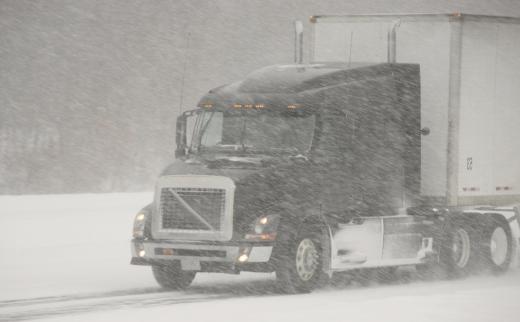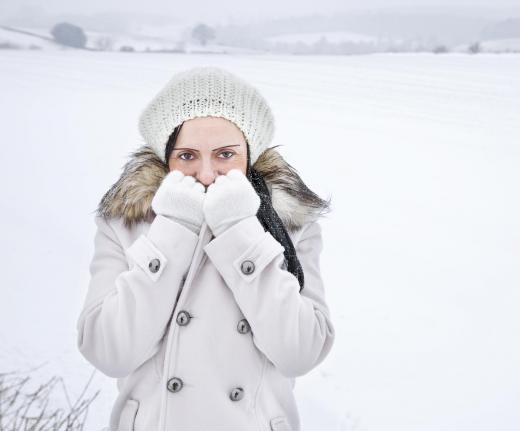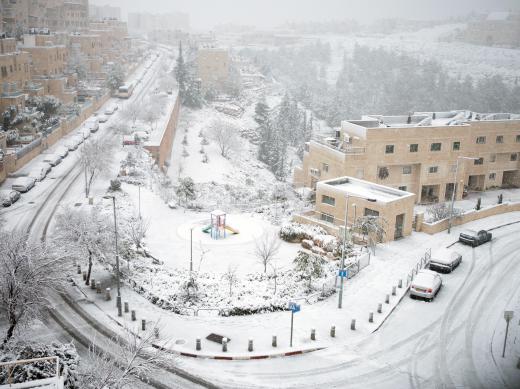What is an Arctic Front?
 Mary McMahon
Mary McMahon
An arctic front is a boundary between an arctic air mass and a polar air mass. This boundary tends to exist more or less continually in northern latitudes, although it will change location as seasonal weather patterns are expressed. The equivalent on the other end of the planet is an antarctic front. The movement of arctic fronts is a topic of interest among meteorologists and weather researchers.
Arctic air masses tend to be cold and dry. When they run up against a polar air mass, which is slightly warmer, the arctic air mass creates a wedge which pushes under the polar air. This causes air movements which can lead to weather phenomena such as rain and snow along the line of the arctic front. This “cold front” can create weather which may range from relatively mild to quite intense, depending on a number of meteorological factors.

People who live at high latitudes often experience winter weather which is brought by arctic fronts. In the winter, the arctic front tends to drift south in response to changing weather patterns, dragging snow and rain with it. Sometimes a front may hover in an area for an extended period of time, dumping a high volume of snow. Eventually, the arctic front will be pushed further south or further north.

As an arctic front retreats, the weather warms up, because the warmer polar air mass is moving over the landscape. In areas where the arctic air mass moves in to stay, the weather can get much colder, because of the cooler temperature of the arctic air mass. Snow and ice will be retained as a result, because the weather does not warm up enough to permit melting. In some areas, snow may remain all winter long as a result of extremely cold conditions.

The arctic front can also pose a threat to travelers. It is generally dangerous to drive or fly during heavy winter weather because visibility is obscured and high winds can present a hazard. People may be forced off course and may not realize it if heavy snowfall has occurred, as this can obscure landmarks and the landscape in general. Arctic fronts are also a matter of concern when it comes to maintaining comfortable living conditions, as the blast of cold weather can require extra work from heating systems to keep structures at a usable and comfortable level of warmth for their occupants.
AS FEATURED ON:
AS FEATURED ON:















Discussion Comments
The climate where I live is subtropical, so we don't have to deal with snow here. However, when arctic air masses do force cold fronts our way, we get winter thunderstorms. Instead of blizzards, we get extreme wind gusts and downpours of rain.
Since the air here is fairly warm even in the winter, cold fronts can mean severe storms. Already this season, we have had two severe weather events, in which the entire northern half of my state stayed under a tornado watch for nearly twelve hours. Some tornadoes were actually spotted, but the majority of us just saw hail and lightning.
Honestly, I think I would rather have the snow. I get a terrible feeling of doom whenever tornado watches are issued, and though I love the warm weather we usually have, I might be willing to trade it so that arctic fronts wouldn't cause such a stir when they move into the area.
I live just about as far north as you can go and still be in the United States, and I have to deal with arctic fronts all winter long. It can get pretty miserable, because I am trapped indoors.
The heat has to stay on a lot, and this causes severe sinus problems for me. It dries out my eyes and nasal passages, and I have trouble sleeping at night, because I can't breathe through my nose.
I have to use humidifiers in every room in the house to prevent nosebleeds. They help somewhat, but still, I feel much worse in winter than any other time of the year because of the strong contrast between the temperatures outdoors and indoors.
@wavy58 – Arctic fronts can be fun and also very dangerous if you aren't accustomed to them. My area got hit with an intense snowstorm from an arctic front last year, and driving conditions got scary fast.
The meteorologist had been predicting a pretty big snowstorm, but I had to go to work that day, anyway. I work at a newspaper, and we have to publish our work, no matter what.
It started snowing as I was coming back to the office from lunch. I live further away from work than most of my coworkers, so my boss told me that as soon as I finished laying out the classified pages, I could go.
Well, that took me about forty-five minutes. During this time, snow had accumulated quickly. My windshield was caked in it.
I went to scraping it off the front, but while I was scraping the back windshield, the front got coated again. I had never seen snow fall that fast! I had to drive under 30 mph all the way home, and the drive that usually takes me thirty minutes took an hour and a half.
We don't see nearly as many arctic fronts in the South as my relatives up North do. However, last winter, we got one of the most intense arctic fronts we had ever experienced.
The weather had been chillier than usual for a couple of weeks. The average winter temperature where I live is in the fifties, yet we had been having thirty degree temps for awhile.
When a new arctic front pushed into the area, it brought snow, a real rarity around here. The most we ever get is around two inches, but this time, we got eight!
Kids went nuts and everyone went sledding. School and work got canceled for most people, because the counties just aren't equipped to deal with snow here.
Post your comments